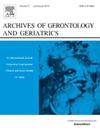Wakefulness after sleep offset and the elevated risk of mortality in older adults with evening preferences: A community-based 5-year longitudinal study
IF 3.5
3区 医学
Q2 GERIATRICS & GERONTOLOGY
引用次数: 0
Abstract
Background and Objectives
This study investigated the relationship between wakefulness after sleep offset timing (WASF), evening chronotype preferences, and mortality risk in community-dwelling older adults.
Research design and methods
We conducted a community-based longitudinal study with a sample of 4167 older adults aged ≥60. The sleep characteristics, WASF, subjective chronotype preferences, and other relevant variables of the participants at baseline were evaluated. We examined the association between WASF and mortality over a 5-year period using Cox proportional hazards models, with stratification by subjective chronotype preferences to explore potential effect modification.
Results
Data from 3734 participants were analyzed (71.1 ± 6.9 years; 2114 [56.6 %] women). The 5-year mortality incidence was 6.3 %. Overall, participants had a median (IQR) of 5.0 (2–20) min WASF, and 767 (20.6 %) were evening types. WASF of ≤5 min = 10.6 (95 % CI, 8.9–12.8), WASF of >5 min = 14.6 (95 % CI, 12.1–17.6). The mortality incidence rates per 1000 person-years were: WASF of ≤5 min = 10.6 (95 % CI, 8.9–12.8) and WASF of >5 min = 14.6 (95 % CI, 12.1–17.6). Even after adjusting for covariates, the longer WASF participants had a higher hazard ratio of 1.40 (95 % CI, 1.04–1.88) compared to the shorter WASF participants. Regular, prolonged WASF was found to be significantly associated with an increased risk of mortality among evening-type individuals (2.69; 95 % CI: 1.19–6.08) in the stratified model based on subjective chronotype preferences. However, we found no statistically significant association among the other types.
Discussion and implications
Reducing morning time in bed, and addressing prolonged WASF are crucial factors in decreasing mortality risk among older adults, especially among those with evening preferences.
一项基于社区的5年纵向研究:夜间偏好的老年人睡眠抵消后的觉醒和死亡风险增加
背景与目的本研究调查了居住在社区的老年人在睡眠补偿时间(WASF)后的觉醒、夜间睡眠类型偏好和死亡风险之间的关系。研究设计和方法我们对4167名年龄≥60岁的老年人进行了一项以社区为基础的纵向研究。评估受试者基线时的睡眠特征、WASF、主观时型偏好及其他相关变量。我们使用Cox比例风险模型研究了5年内WASF与死亡率之间的关系,并通过主观时间类型偏好分层来探索潜在的影响修正。结果分析了3734名参与者的数据(71.1±6.9年;2114名[56.6%]女性)。5年死亡率为6.3%。总体而言,参与者的中位数(IQR)为5.0 (2-20)min WASF, 767(20.6%)为夜间型。≤5 min的WASF = 10.6 (95% CI, 8.9-12.8),≤5 min的WASF = 14.6 (95% CI, 12.1-17.6)。每1000人年的死亡率为:WASF≤5 min = 10.6 (95% CI, 8.9-12.8), WASF≤5 min = 14.6 (95% CI, 12.1-17.6)。即使在调整协变量后,与较短的WASF参与者相比,较长的WASF参与者的风险比更高,为1.40 (95% CI, 1.04-1.88)。在夜猫子个体中,定期、长期的WASF与死亡风险增加显著相关(2.69;95% CI: 1.19-6.08)在基于主观时型偏好的分层模型中。然而,我们发现其他类型之间没有统计学上显著的关联。讨论和意义减少早晨的卧床时间和解决延长的睡眠时间是降低老年人死亡风险的关键因素,尤其是那些喜欢晚上睡觉的老年人。
本文章由计算机程序翻译,如有差异,请以英文原文为准。
求助全文
约1分钟内获得全文
求助全文
来源期刊
CiteScore
7.30
自引率
5.00%
发文量
198
审稿时长
16 days
期刊介绍:
Archives of Gerontology and Geriatrics provides a medium for the publication of papers from the fields of experimental gerontology and clinical and social geriatrics. The principal aim of the journal is to facilitate the exchange of information between specialists in these three fields of gerontological research. Experimental papers dealing with the basic mechanisms of aging at molecular, cellular, tissue or organ levels will be published.
Clinical papers will be accepted if they provide sufficiently new information or are of fundamental importance for the knowledge of human aging. Purely descriptive clinical papers will be accepted only if the results permit further interpretation. Papers dealing with anti-aging pharmacological preparations in humans are welcome. Papers on the social aspects of geriatrics will be accepted if they are of general interest regarding the epidemiology of aging and the efficiency and working methods of the social organizations for the health care of the elderly.

 求助内容:
求助内容: 应助结果提醒方式:
应助结果提醒方式:


